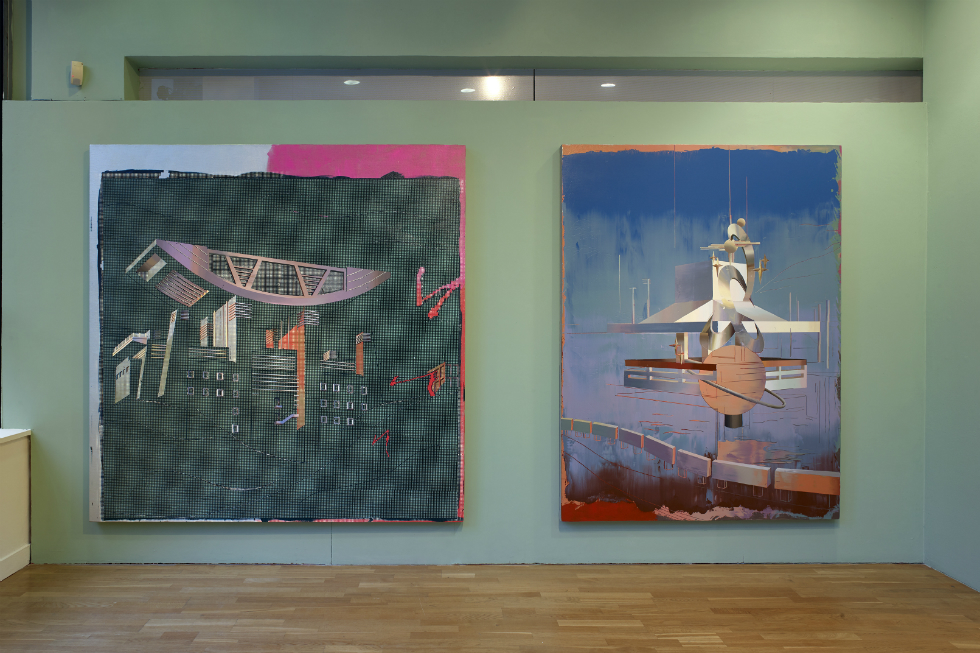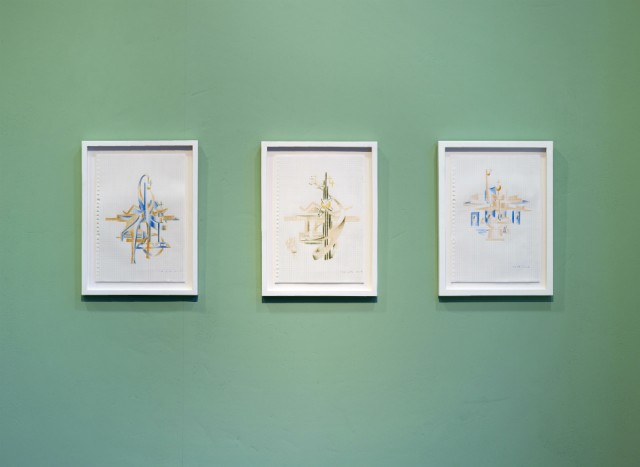Cui Jie: From Pavilion to Space Station – Reviewed

An exhibition addressing how shifts in architectural style reflect national identity, Cui Jie’s From Pavilion to Space Station’s small scale belies its big ideas, finds Mike Pinnington…
What can architecture tell us about a place, its citizens, their beliefs and the impression they want to project to the world? These concerns are addressed in one of a pair of related exhibitions currently on display at Manchester’s Centre for Chinese Contemporary Art. The latest iteration of CFCCA’s Future Cities strand of programming, it sets out to investigate the ‘intersection between art and architecture’ through real and imagined urban spaces.
In Cui Jie’s From Pavilion to Space Station, we find an artist working at that very junction. Allotted the smaller of the centre’s two exhibition spaces, it makes for a relatively slight presentation of five works (all made this year). Dominating the room are a pair of large-scale paintings (above). Without context, they could be confused for lavishly executed reproductions of old, Golden Age of Science Fiction book covers, or glimpses of an alternative, unseen version of Blade Runner, as imagined by designer and neo-futuristic concept artist, Syd Mead.
The larger of the works, The Second Generation of Peak Tower 2, depicts an imposing and brutally (if not brutalist) futuristic building as viewed from below at night-time. Handsomely rendered in layered Acrylic and spray paint, it is beautiful and yet foreboding – a subtle evocation of soft power it isn’t. Alongside it, The Lakeside Pavilion is airier somehow; appearing to hover in space and incorporating a ringed planet, it conjures a sleeker, more utopian vision. Darkness and light, roiling nightmare and vivid daydream hang side-by-side, twin suggestions of what is and what might have been, or could still be. Despite such fantastical appearances, each of these paintings are grounded in reality, having been made in response to the architectural evolution – taking in everything from Chinese propaganda and communism to modernism and beyond – atop Victoria Peak, in Hong Kong.

Overlooking the Island’s harbour, successive pavilions have variously been symbols of ‘power, colonial legacy, capitalism and [most recently] tourism’. The location confers a breath-taking view that, no doubt, presents ideal Instagrammable opportunities. In the last century, three different pavilions have occupied the site, each reflecting their particular geopolitical moment; the original, destroyed by invading Japanese forces during the Second World War, was of traditional Chinese design.
Flash forward to 1972 and the ancient China-inspired design by architect Chung Wah-nan is represented here by an accompanying set of three small coloured pencil on paper drawings (above). Respectively, Chung Wah-nan’s Listening Falls Pavilion; Chung Wah-nan’s Listening Falls Pavilion 2; and Chung Wah-nan’s Pavilion in West Lake Park are exquisite, A4-sized flights of fancy. They are like cities in the sky; or, perhaps more accurately, the heavens – spaceports to greet interstellar dignitaries.
Chung Wah-nan’s real-life Victoria Peak pavilion was demolished in 1993 in order to make way for the current imperious build. This was completed in 1997 – the same year in which the United Kingdom transferred its sovereignty and administration for the colony of Hong Kong to China. With the intention for the territory to retain autonomy from the mainland, it can only be read, I suppose, as something of a pointed statement that British architect Terry Farrell was chosen to oversee the work.
With Hong Kong currently experiencing an existential tug of war, evidence of literal and ideological battles, lessons learned – or not – can be found running like a rich thread through Cui Jie’s From Pavilion to Space Station. Judiciously utilising contemporary and historical architecture as the prism by which to reveal prevailing agendas and concerns, to describe Cui Jie’s impressive and deceptively deep works as timely and thought provoking is an understatement. I only wish there were more of them.
Mike Pinnington
Cui Jie: From Pavilion to Space Station continues @ the Centre for Chinese Contemporary Art until 12 January
Images: Cui Jie, From Pavilion to Space Station, at CFCCA (2019). Photographs by Michael Pollard





